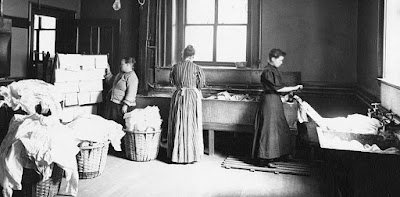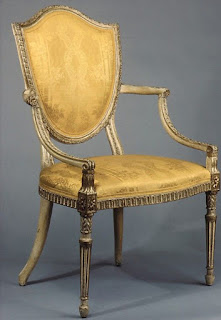Public opinion decried the occupation of seamstress
but offered no alternatives.
In looking at women who made a living doing needlework I have found that 19th-century attitudes considered seamstresses quite low on the scale of occupations. There were a couple of jobs open to females that were lower, however, among them prostitution and thievery.
Vanity Fair, 1861
Racial stereotyping of Irish laundress in a Civil War camp
One socially acceptable profession a step below seamstress was that of washerwoman. It was a job for the uneducated, the non-English speaker, the recent immigrant, the slave and the free-woman-of-color.
The Irish washerwoman was such a cliche that there is a fiddle tune with the name.
And nobody wanted one in New York City during the anti-Irish bigotry of the 1850s.
It wasn't that the job was unskilled labor; the advantage was
that it required no formal education. Another advantage:
There was always plenty of laundry to be done.
The stereotype is of a Chinese laundry man
but there must have been plenty of women working in Chinese laundries.
Civil war army laundress by Winslow Homer for Harper's Weekly
Hard, back-breaking work is another cliche.
Laundry wasn't only about getting the clothes and household linens clean, the laundress finished
with ironing in the age of starched cottons and linens. Catherine Beecher will tell you the basics in her 1841 book A Treatise on Domestic Economy: For the Use of Young Ladies at Home
Page 275
See Chapter 26 "On Washing"
Basic tools of the trade: a wooden laundry tub,
a barrel with staves so tight it holds water.
Note the iron on the ground in front of the tub of this army laundress during the Civil War.
The man is holding another basic tool, a wooden stick for agitating the wet laundry, called a laundry dolly in England. Beecher calls it a wash stick and says you need a wooden fork too, to remove the wet clothes.
This may be England, where the woman on the left is
agitating the clothes.
British washer women
An insult to the Scottish laundress
and some soft core pornography. Legs!
Mrs. Hallam, 1932
Archives of New Zealand
Another vital tool: Wash board to scrub stains.
This woman photographed in 1863 seems to have
a more sophisticated tool for scrubbing.
Jack Delano photo
Buckets from the pump in an Iowa winter in the 1940s
The hard work also involved obtaining the water. And as there was no cold water soap....
Photo by Arnold Genthe, New Orleans, 1920
Boiling the water first in a metal container
One needed some kind of a wringer to get the water out.
Then the clothes were dried---on a sunny day in the yard if one was lucky.
Boston 1905
Inside if it looked like rain
And then the ironing began.
There was no spray starch. You added the starch in a starch tub when the clothes were wet.
And if you go back to Catherine Beecher's time there was no commercial starch. She said you needed a supply of "starch, neither sour or musty....Before hanging out, dip [the clothes] in starch, clapping it in, so as to have the equally stiff, in all parts."
You had to make your own starch and your own lye (she spelled it ley.)
They hadn't invented the electric iron yet. Heck, they hadn't invented
the ironing board yet.
Doris Ulmann photographed a woman using a "sad iron" in the 1930s. You heat a sad iron on a stove and use it with a pot holder while it remains hot. You have another iron in the fire waiting.
Russell Lee photographed a refugee ironing with a sad iron in a tent
in Oklahoma in the late 1930s.
Jack Delano photo, Georgia
Once everything was starched, ironed and primped there was optional delivery.
Bowling Green, Ohio
by Lewis Hine
Steam Laundry delivery, Alaska
After considering the whole occupation of washerwoman I have
a new respect for a skilled occupation.
Refugees in a cabin
Russell Lee, Oklahoma
"Washings and Iornings
Done Here"
Bertha Bridges's 1940's string star quilt is on view right now
at the North Carolina Museum of History in QuiltSpeak.
She raised her daughter in Shelby County, North Carolina by working as a laundress,
sending her to the Hampton Institute and Columbia University.
https://civilwar.gratzpa.org/2015/06/mary-kilraine-of-williamstown-civil-war-laundress/
And read Tubs & Suds: Civil War Laundresses in the Field, Camp & Hospital by Virginia Mescher:
http://www.raggedsoldier.com/final_laundry_vv.pdf























































